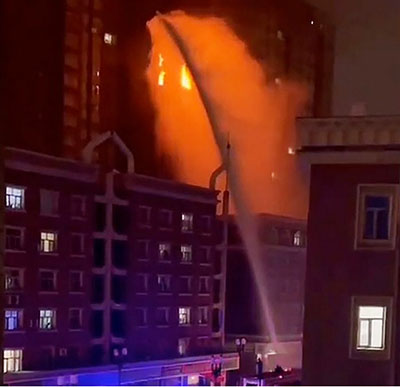by WorldTribune Staff, December 2, 2022
Demonstrators in China said firefighters were unable to respond to and contain a blaze at an apartment building in Urumqi, capital of the heavily Muslim region of Xinjiang, where an unknown number of people died because of the communist regime’s Covid-19 lockdown.
In the aftermath of the fire, China’s army of censors and network systems failed to control the outrage that spread nationwide. The Chinese Communist Party’s Great Internet Firewall was breached and nationwide protests not seen since the 1989 pro-democracy movement at Tiananmen Sqare erupted.

An online chat group formed by residents in the 21-story apartment building in China’s far western Xinjiang province was filled by panicked messages. “On the 16th floor, we don’t have enough oxygen,” a woman said in an audio message. “Soon our children won’t be OK.”
Another post pleaded for help for people in apartment 1901: “They wouldn’t be able to open the door. Can you break into it and take a look? There are many children inside.”
Firefighters didn’t reach some of the apartments until around 90 minutes after they were called, according to posts on the chat group. Witnesses said that fire engines were blocked by cars that had been parked on the street for months because of the lockdown. The cars wouldn’t start and couldn’t be moved.
“Video footage showed that traffic-control structures had to be removed as a line of fire trucks waited, causing delays. The government denied the structures had been installed for pandemic-control reasons,” the Wall Street Journal reported on Dec. 1.
It reportedly took firefighters three hours to control the fire.
Related: China denies transforming Xinjiang province into ‘no rights zone’, August 15, 2018
Individuals who joined anti-lockdown protests across the country believe the delays in containing the fire and helping those trapped inside the apartment building happened in large part because of the pandemic restrictions.
“Demonstrations were fueled by the group chat conversations and footage of obstructed fire trucks, as well as by videos circulating online that appeared to capture the screams of people from the smoldering building,” the Journal report said.
“Open the gate!” one woman could be heard shouting in one video.
It is also believed that the death toll from the fire is much higher than the official report of 10.
“Outrage spilled onto the streets of Urumqi, the capital of the heavily Muslim Chinese region of Xinjiang, where residents had been locked down for more than 100 days,” the Journal reported.
Video footage of the fire and the protest in Urumqi spread on Chinese social media and on the popular WeChat app.
On the Twitter-like Weibo platform, one widely endorsed comment about the fire said: “The 100-plus day lockdown is real. The many deaths from Covid controls are real. Discontent has accumulated and is destined to erupt.”
Within days, the protests spread throughout China.
“The demonstrations have posed a rare challenge to the recently extended rule of Chinese leader Xi Jinping, compounding the government’s challenges over how to ease its Covid restrictions,” the Journal noted.
Prior to the new wave of protests, communist authorities had managed to contain online criticism of Xi’s purges, crackdowns and zero-Covid restrictions.
That criticism first erupted after the death from the coronavirus of Li Wenliang, a doctor who was punished for warning others about the initial outbreak in Wuhan.
This September, a bus crash in Guizhou province that killed 27 people who were being sent to quarantine in the middle of the night raised an outcry about steps taken to control the coronavirus.
Outrage over those incidents did not make it over the Great Internet Firewall.
Action . . . . Intelligence . . . . Publish
